Auditing and Assurance Report: Bendigo Bank's Financials 2018
VerifiedAdded on 2022/09/26
|10
|1646
|19
Report
AI Summary
This report provides a comprehensive analysis of the auditing and assurance procedures applied to Bendigo and Adelaide Bank's financial statements for the year ending 2018. It begins by determining the level of materiality, discussing its nature and different bases for calculation, and providing a quantitative estimate. The report then reviews significant items from the annual report, such as contingencies and impairment, outlining necessary audit procedures. Section 2 focuses on preliminary analytical review, including ratio analysis to assess profitability and leverage. Section 3 reviews the cash flow statement, identifying potential going concern issues, and analyzes the audit report issued by Ernst & Young, highlighting key audit issues. The analysis is based on relevant auditing and assurance standards and the provided annual report, with appropriate citations and references.

Running head: AUDITING AND ASSURANCE IN AUSTRALIA
Auditing and assurance in Australia
Name of the student
Name of the university
Student ID
Author note
Auditing and assurance in Australia
Name of the student
Name of the university
Student ID
Author note
Paraphrase This Document
Need a fresh take? Get an instant paraphrase of this document with our AI Paraphraser
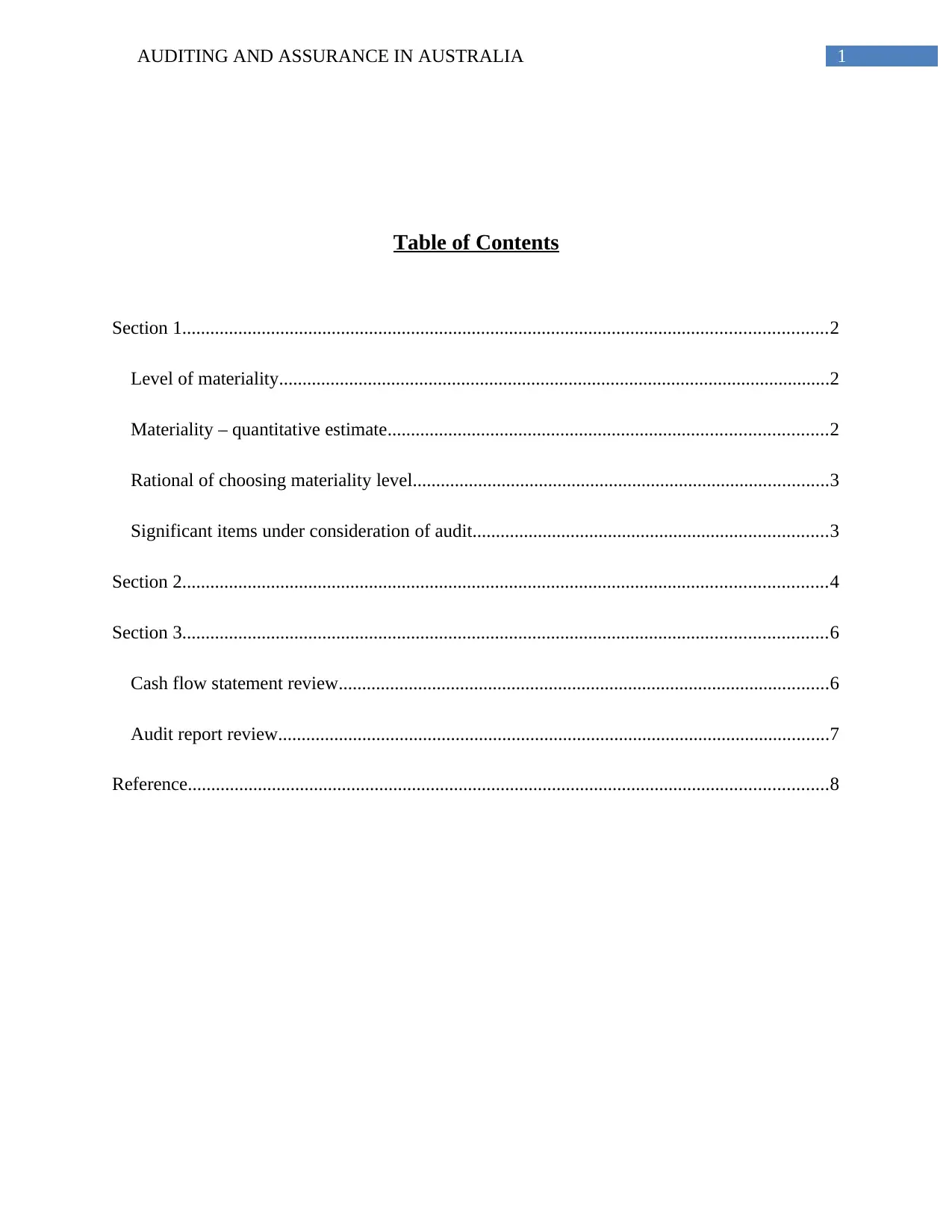
1AUDITING AND ASSURANCE IN AUSTRALIA
Table of Contents
Section 1..........................................................................................................................................2
Level of materiality......................................................................................................................2
Materiality – quantitative estimate..............................................................................................2
Rational of choosing materiality level.........................................................................................3
Significant items under consideration of audit............................................................................3
Section 2..........................................................................................................................................4
Section 3..........................................................................................................................................6
Cash flow statement review.........................................................................................................6
Audit report review......................................................................................................................7
Reference.........................................................................................................................................8
Table of Contents
Section 1..........................................................................................................................................2
Level of materiality......................................................................................................................2
Materiality – quantitative estimate..............................................................................................2
Rational of choosing materiality level.........................................................................................3
Significant items under consideration of audit............................................................................3
Section 2..........................................................................................................................................4
Section 3..........................................................................................................................................6
Cash flow statement review.........................................................................................................6
Audit report review......................................................................................................................7
Reference.........................................................................................................................................8
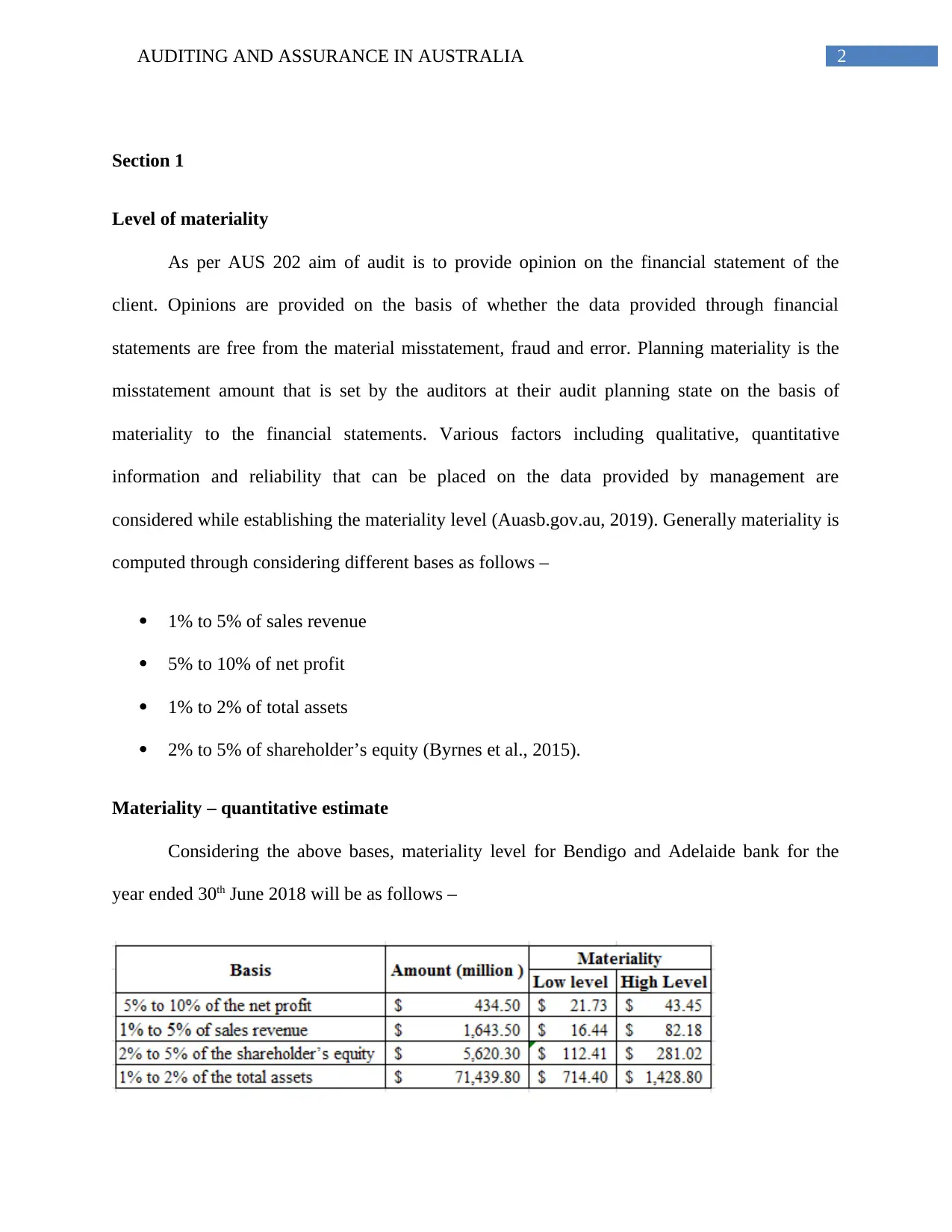
2AUDITING AND ASSURANCE IN AUSTRALIA
Section 1
Level of materiality
As per AUS 202 aim of audit is to provide opinion on the financial statement of the
client. Opinions are provided on the basis of whether the data provided through financial
statements are free from the material misstatement, fraud and error. Planning materiality is the
misstatement amount that is set by the auditors at their audit planning state on the basis of
materiality to the financial statements. Various factors including qualitative, quantitative
information and reliability that can be placed on the data provided by management are
considered while establishing the materiality level (Auasb.gov.au, 2019). Generally materiality is
computed through considering different bases as follows –
1% to 5% of sales revenue
5% to 10% of net profit
1% to 2% of total assets
2% to 5% of shareholder’s equity (Byrnes et al., 2015).
Materiality – quantitative estimate
Considering the above bases, materiality level for Bendigo and Adelaide bank for the
year ended 30th June 2018 will be as follows –
Section 1
Level of materiality
As per AUS 202 aim of audit is to provide opinion on the financial statement of the
client. Opinions are provided on the basis of whether the data provided through financial
statements are free from the material misstatement, fraud and error. Planning materiality is the
misstatement amount that is set by the auditors at their audit planning state on the basis of
materiality to the financial statements. Various factors including qualitative, quantitative
information and reliability that can be placed on the data provided by management are
considered while establishing the materiality level (Auasb.gov.au, 2019). Generally materiality is
computed through considering different bases as follows –
1% to 5% of sales revenue
5% to 10% of net profit
1% to 2% of total assets
2% to 5% of shareholder’s equity (Byrnes et al., 2015).
Materiality – quantitative estimate
Considering the above bases, materiality level for Bendigo and Adelaide bank for the
year ended 30th June 2018 will be as follows –
⊘ This is a preview!⊘
Do you want full access?
Subscribe today to unlock all pages.

Trusted by 1+ million students worldwide
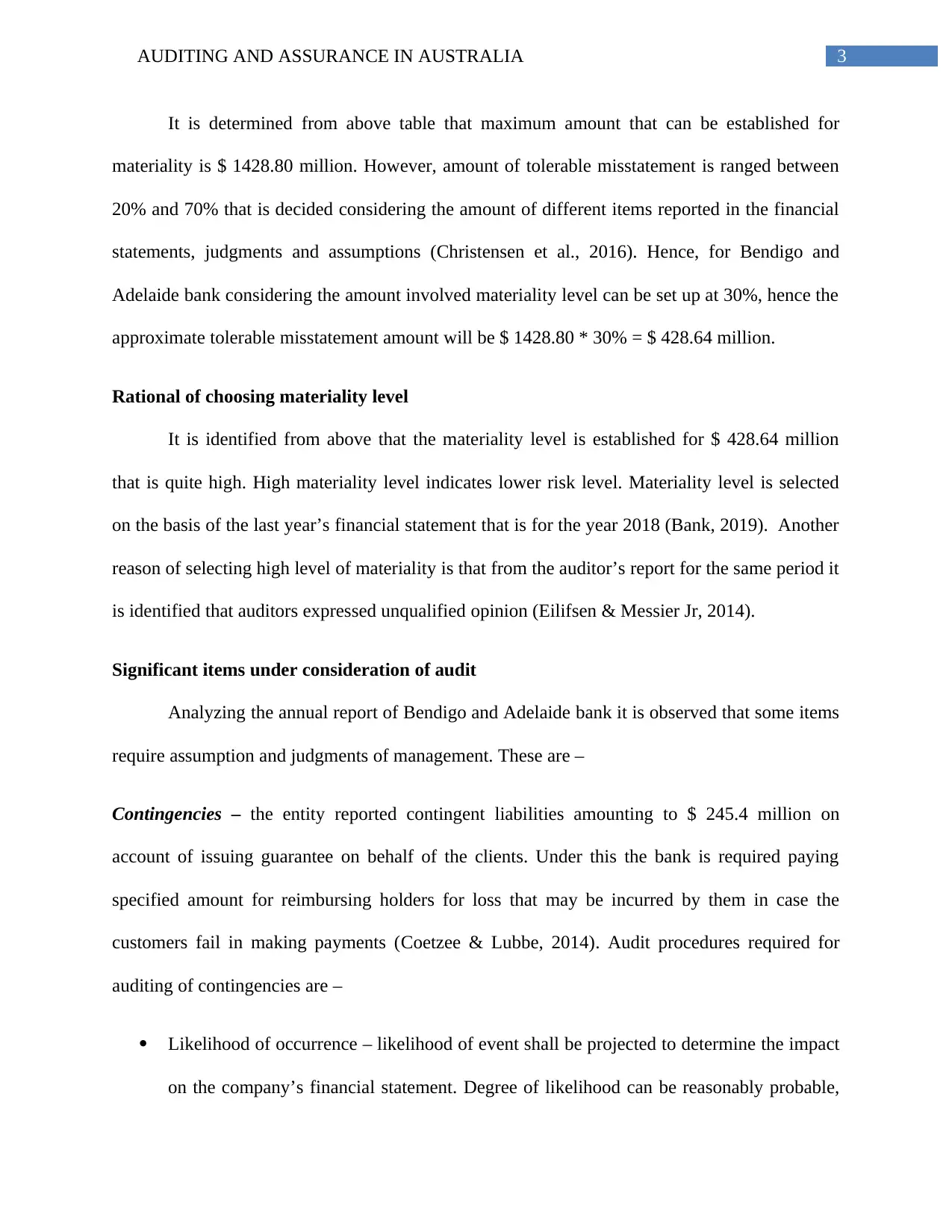
3AUDITING AND ASSURANCE IN AUSTRALIA
It is determined from above table that maximum amount that can be established for
materiality is $ 1428.80 million. However, amount of tolerable misstatement is ranged between
20% and 70% that is decided considering the amount of different items reported in the financial
statements, judgments and assumptions (Christensen et al., 2016). Hence, for Bendigo and
Adelaide bank considering the amount involved materiality level can be set up at 30%, hence the
approximate tolerable misstatement amount will be $ 1428.80 * 30% = $ 428.64 million.
Rational of choosing materiality level
It is identified from above that the materiality level is established for $ 428.64 million
that is quite high. High materiality level indicates lower risk level. Materiality level is selected
on the basis of the last year’s financial statement that is for the year 2018 (Bank, 2019). Another
reason of selecting high level of materiality is that from the auditor’s report for the same period it
is identified that auditors expressed unqualified opinion (Eilifsen & Messier Jr, 2014).
Significant items under consideration of audit
Analyzing the annual report of Bendigo and Adelaide bank it is observed that some items
require assumption and judgments of management. These are –
Contingencies – the entity reported contingent liabilities amounting to $ 245.4 million on
account of issuing guarantee on behalf of the clients. Under this the bank is required paying
specified amount for reimbursing holders for loss that may be incurred by them in case the
customers fail in making payments (Coetzee & Lubbe, 2014). Audit procedures required for
auditing of contingencies are –
Likelihood of occurrence – likelihood of event shall be projected to determine the impact
on the company’s financial statement. Degree of likelihood can be reasonably probable,
It is determined from above table that maximum amount that can be established for
materiality is $ 1428.80 million. However, amount of tolerable misstatement is ranged between
20% and 70% that is decided considering the amount of different items reported in the financial
statements, judgments and assumptions (Christensen et al., 2016). Hence, for Bendigo and
Adelaide bank considering the amount involved materiality level can be set up at 30%, hence the
approximate tolerable misstatement amount will be $ 1428.80 * 30% = $ 428.64 million.
Rational of choosing materiality level
It is identified from above that the materiality level is established for $ 428.64 million
that is quite high. High materiality level indicates lower risk level. Materiality level is selected
on the basis of the last year’s financial statement that is for the year 2018 (Bank, 2019). Another
reason of selecting high level of materiality is that from the auditor’s report for the same period it
is identified that auditors expressed unqualified opinion (Eilifsen & Messier Jr, 2014).
Significant items under consideration of audit
Analyzing the annual report of Bendigo and Adelaide bank it is observed that some items
require assumption and judgments of management. These are –
Contingencies – the entity reported contingent liabilities amounting to $ 245.4 million on
account of issuing guarantee on behalf of the clients. Under this the bank is required paying
specified amount for reimbursing holders for loss that may be incurred by them in case the
customers fail in making payments (Coetzee & Lubbe, 2014). Audit procedures required for
auditing of contingencies are –
Likelihood of occurrence – likelihood of event shall be projected to determine the impact
on the company’s financial statement. Degree of likelihood can be reasonably probable,
Paraphrase This Document
Need a fresh take? Get an instant paraphrase of this document with our AI Paraphraser

4AUDITING AND ASSURANCE IN AUSTRALIA
remote or probable. Disclosure for contingencies is only provided in case the likelihood is
probable or reasonably probable (Bank, 2019).
Materiality of transaction – auditors are required to determine materiality threshold
before analysis of individual liability. If liability exceeds the limit, it is accounted as will
have significant impact on the financial reports (Kharisova & Kozlova, 2014).
Impairment – it is considered as significant as it involves higher level of estimation and
judgment for assessing impairment. Judgment and estimation is required for determining whether
the carrying value of the asset indicates impairment (Bank, 2019). Audit procedures required for
auditing of contingencies are –
Reviewing the asset to verify that ASB 136 is followed for charging impairment. Further,
the audit procedure used for impairment assessment by the management shall be
reviewed.
Comparing forecasted cash flows that are approved by board and to consider past event’s
impact on forecast (Glover & Prawitt, 2014).
Section 2
Preliminary analytical review involves management’s procedure for enquiry applicable at
the stage of audit planning. One of the processes that can be used for carrying out preliminary
analytical review is ratio analysis as follows –
remote or probable. Disclosure for contingencies is only provided in case the likelihood is
probable or reasonably probable (Bank, 2019).
Materiality of transaction – auditors are required to determine materiality threshold
before analysis of individual liability. If liability exceeds the limit, it is accounted as will
have significant impact on the financial reports (Kharisova & Kozlova, 2014).
Impairment – it is considered as significant as it involves higher level of estimation and
judgment for assessing impairment. Judgment and estimation is required for determining whether
the carrying value of the asset indicates impairment (Bank, 2019). Audit procedures required for
auditing of contingencies are –
Reviewing the asset to verify that ASB 136 is followed for charging impairment. Further,
the audit procedure used for impairment assessment by the management shall be
reviewed.
Comparing forecasted cash flows that are approved by board and to consider past event’s
impact on forecast (Glover & Prawitt, 2014).
Section 2
Preliminary analytical review involves management’s procedure for enquiry applicable at
the stage of audit planning. One of the processes that can be used for carrying out preliminary
analytical review is ratio analysis as follows –
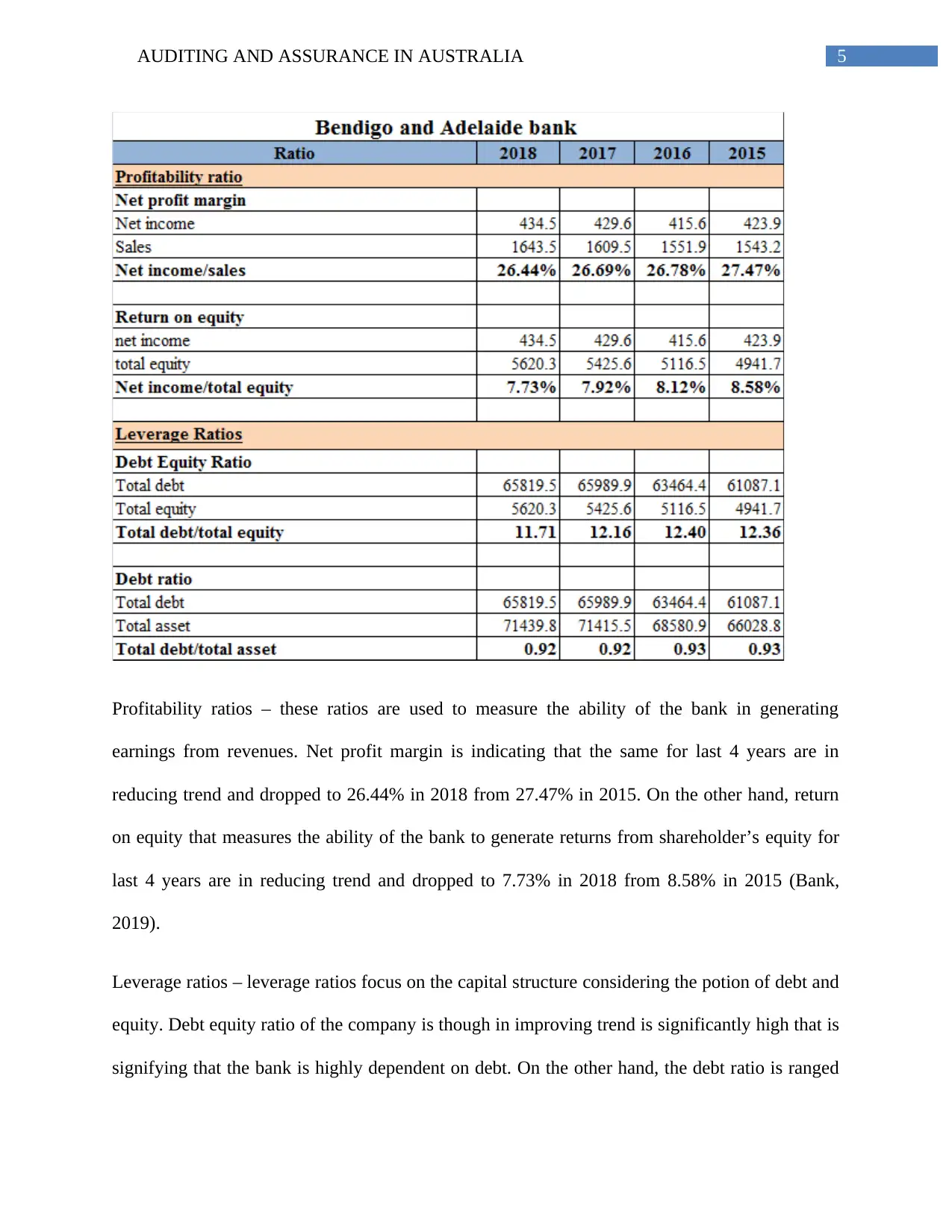
5AUDITING AND ASSURANCE IN AUSTRALIA
Profitability ratios – these ratios are used to measure the ability of the bank in generating
earnings from revenues. Net profit margin is indicating that the same for last 4 years are in
reducing trend and dropped to 26.44% in 2018 from 27.47% in 2015. On the other hand, return
on equity that measures the ability of the bank to generate returns from shareholder’s equity for
last 4 years are in reducing trend and dropped to 7.73% in 2018 from 8.58% in 2015 (Bank,
2019).
Leverage ratios – leverage ratios focus on the capital structure considering the potion of debt and
equity. Debt equity ratio of the company is though in improving trend is significantly high that is
signifying that the bank is highly dependent on debt. On the other hand, the debt ratio is ranged
Profitability ratios – these ratios are used to measure the ability of the bank in generating
earnings from revenues. Net profit margin is indicating that the same for last 4 years are in
reducing trend and dropped to 26.44% in 2018 from 27.47% in 2015. On the other hand, return
on equity that measures the ability of the bank to generate returns from shareholder’s equity for
last 4 years are in reducing trend and dropped to 7.73% in 2018 from 8.58% in 2015 (Bank,
2019).
Leverage ratios – leverage ratios focus on the capital structure considering the potion of debt and
equity. Debt equity ratio of the company is though in improving trend is significantly high that is
signifying that the bank is highly dependent on debt. On the other hand, the debt ratio is ranged
⊘ This is a preview!⊘
Do you want full access?
Subscribe today to unlock all pages.

Trusted by 1+ million students worldwide
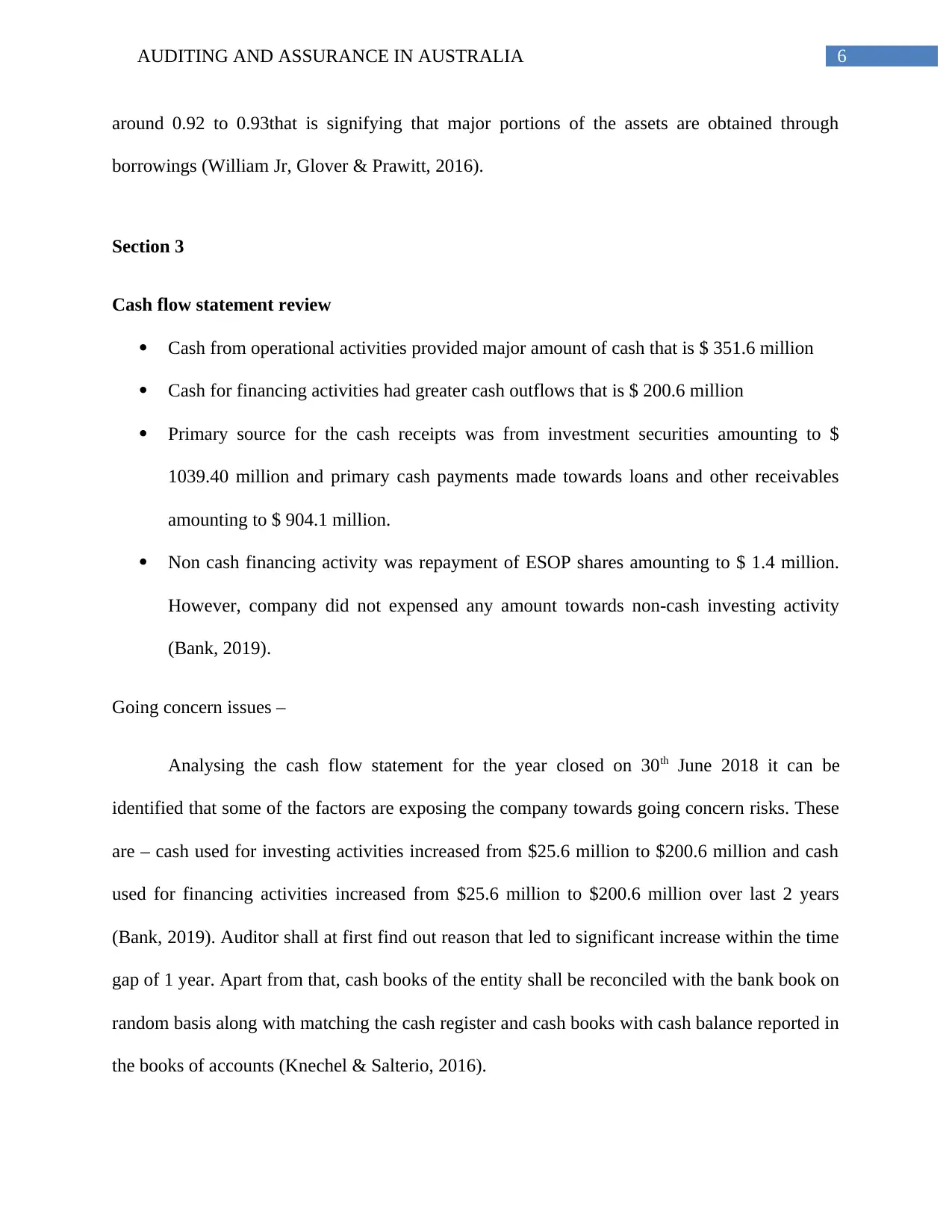
6AUDITING AND ASSURANCE IN AUSTRALIA
around 0.92 to 0.93that is signifying that major portions of the assets are obtained through
borrowings (William Jr, Glover & Prawitt, 2016).
Section 3
Cash flow statement review
Cash from operational activities provided major amount of cash that is $ 351.6 million
Cash for financing activities had greater cash outflows that is $ 200.6 million
Primary source for the cash receipts was from investment securities amounting to $
1039.40 million and primary cash payments made towards loans and other receivables
amounting to $ 904.1 million.
Non cash financing activity was repayment of ESOP shares amounting to $ 1.4 million.
However, company did not expensed any amount towards non-cash investing activity
(Bank, 2019).
Going concern issues –
Analysing the cash flow statement for the year closed on 30th June 2018 it can be
identified that some of the factors are exposing the company towards going concern risks. These
are – cash used for investing activities increased from $25.6 million to $200.6 million and cash
used for financing activities increased from $25.6 million to $200.6 million over last 2 years
(Bank, 2019). Auditor shall at first find out reason that led to significant increase within the time
gap of 1 year. Apart from that, cash books of the entity shall be reconciled with the bank book on
random basis along with matching the cash register and cash books with cash balance reported in
the books of accounts (Knechel & Salterio, 2016).
around 0.92 to 0.93that is signifying that major portions of the assets are obtained through
borrowings (William Jr, Glover & Prawitt, 2016).
Section 3
Cash flow statement review
Cash from operational activities provided major amount of cash that is $ 351.6 million
Cash for financing activities had greater cash outflows that is $ 200.6 million
Primary source for the cash receipts was from investment securities amounting to $
1039.40 million and primary cash payments made towards loans and other receivables
amounting to $ 904.1 million.
Non cash financing activity was repayment of ESOP shares amounting to $ 1.4 million.
However, company did not expensed any amount towards non-cash investing activity
(Bank, 2019).
Going concern issues –
Analysing the cash flow statement for the year closed on 30th June 2018 it can be
identified that some of the factors are exposing the company towards going concern risks. These
are – cash used for investing activities increased from $25.6 million to $200.6 million and cash
used for financing activities increased from $25.6 million to $200.6 million over last 2 years
(Bank, 2019). Auditor shall at first find out reason that led to significant increase within the time
gap of 1 year. Apart from that, cash books of the entity shall be reconciled with the bank book on
random basis along with matching the cash register and cash books with cash balance reported in
the books of accounts (Knechel & Salterio, 2016).
Paraphrase This Document
Need a fresh take? Get an instant paraphrase of this document with our AI Paraphraser
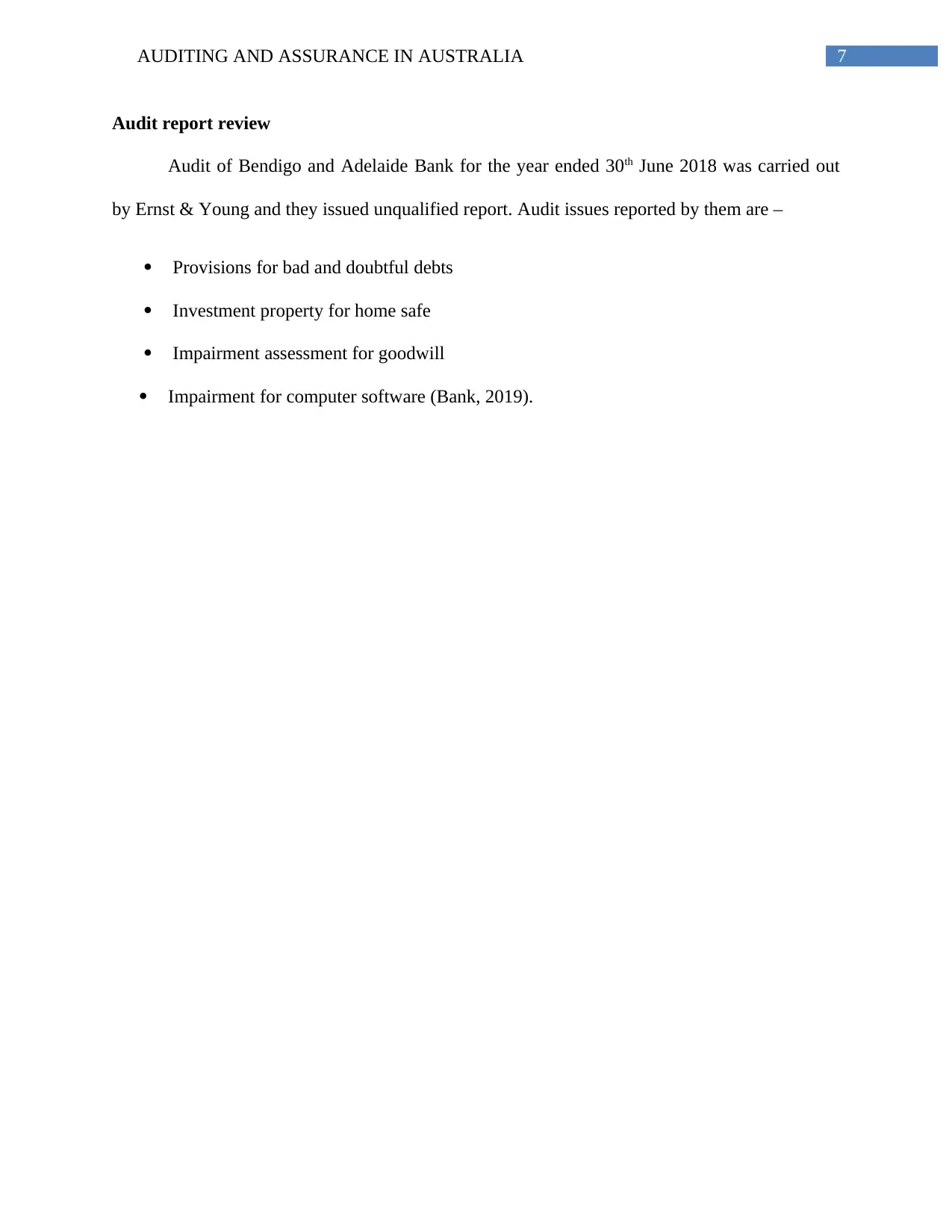
7AUDITING AND ASSURANCE IN AUSTRALIA
Audit report review
Audit of Bendigo and Adelaide Bank for the year ended 30th June 2018 was carried out
by Ernst & Young and they issued unqualified report. Audit issues reported by them are –
Provisions for bad and doubtful debts
Investment property for home safe
Impairment assessment for goodwill
Impairment for computer software (Bank, 2019).
Audit report review
Audit of Bendigo and Adelaide Bank for the year ended 30th June 2018 was carried out
by Ernst & Young and they issued unqualified report. Audit issues reported by them are –
Provisions for bad and doubtful debts
Investment property for home safe
Impairment assessment for goodwill
Impairment for computer software (Bank, 2019).
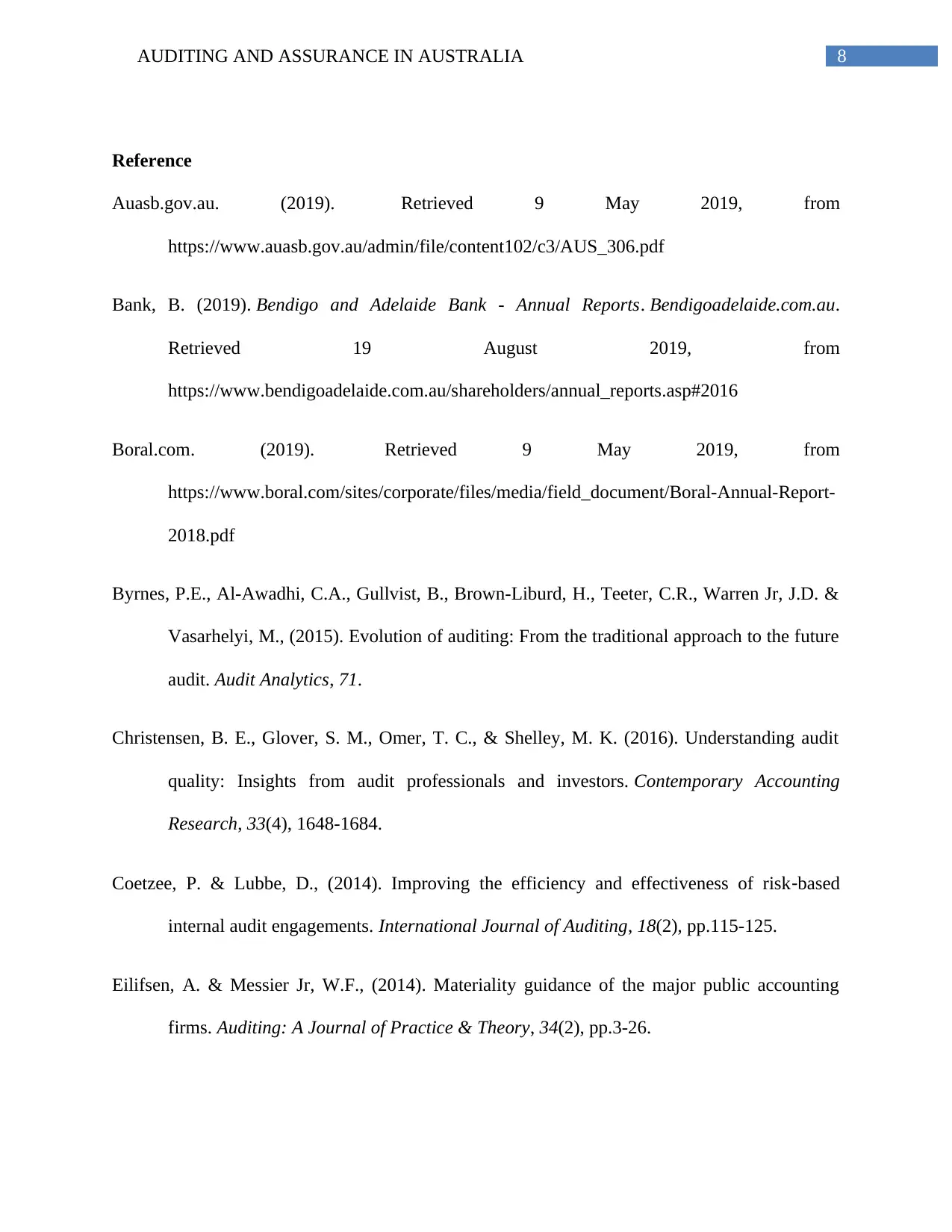
8AUDITING AND ASSURANCE IN AUSTRALIA
Reference
Auasb.gov.au. (2019). Retrieved 9 May 2019, from
https://www.auasb.gov.au/admin/file/content102/c3/AUS_306.pdf
Bank, B. (2019). Bendigo and Adelaide Bank - Annual Reports. Bendigoadelaide.com.au.
Retrieved 19 August 2019, from
https://www.bendigoadelaide.com.au/shareholders/annual_reports.asp#2016
Boral.com. (2019). Retrieved 9 May 2019, from
https://www.boral.com/sites/corporate/files/media/field_document/Boral-Annual-Report-
2018.pdf
Byrnes, P.E., Al-Awadhi, C.A., Gullvist, B., Brown-Liburd, H., Teeter, C.R., Warren Jr, J.D. &
Vasarhelyi, M., (2015). Evolution of auditing: From the traditional approach to the future
audit. Audit Analytics, 71.
Christensen, B. E., Glover, S. M., Omer, T. C., & Shelley, M. K. (2016). Understanding audit
quality: Insights from audit professionals and investors. Contemporary Accounting
Research, 33(4), 1648-1684.
Coetzee, P. & Lubbe, D., (2014). Improving the efficiency and effectiveness of risk‐based
internal audit engagements. International Journal of Auditing, 18(2), pp.115-125.
Eilifsen, A. & Messier Jr, W.F., (2014). Materiality guidance of the major public accounting
firms. Auditing: A Journal of Practice & Theory, 34(2), pp.3-26.
Reference
Auasb.gov.au. (2019). Retrieved 9 May 2019, from
https://www.auasb.gov.au/admin/file/content102/c3/AUS_306.pdf
Bank, B. (2019). Bendigo and Adelaide Bank - Annual Reports. Bendigoadelaide.com.au.
Retrieved 19 August 2019, from
https://www.bendigoadelaide.com.au/shareholders/annual_reports.asp#2016
Boral.com. (2019). Retrieved 9 May 2019, from
https://www.boral.com/sites/corporate/files/media/field_document/Boral-Annual-Report-
2018.pdf
Byrnes, P.E., Al-Awadhi, C.A., Gullvist, B., Brown-Liburd, H., Teeter, C.R., Warren Jr, J.D. &
Vasarhelyi, M., (2015). Evolution of auditing: From the traditional approach to the future
audit. Audit Analytics, 71.
Christensen, B. E., Glover, S. M., Omer, T. C., & Shelley, M. K. (2016). Understanding audit
quality: Insights from audit professionals and investors. Contemporary Accounting
Research, 33(4), 1648-1684.
Coetzee, P. & Lubbe, D., (2014). Improving the efficiency and effectiveness of risk‐based
internal audit engagements. International Journal of Auditing, 18(2), pp.115-125.
Eilifsen, A. & Messier Jr, W.F., (2014). Materiality guidance of the major public accounting
firms. Auditing: A Journal of Practice & Theory, 34(2), pp.3-26.
⊘ This is a preview!⊘
Do you want full access?
Subscribe today to unlock all pages.

Trusted by 1+ million students worldwide
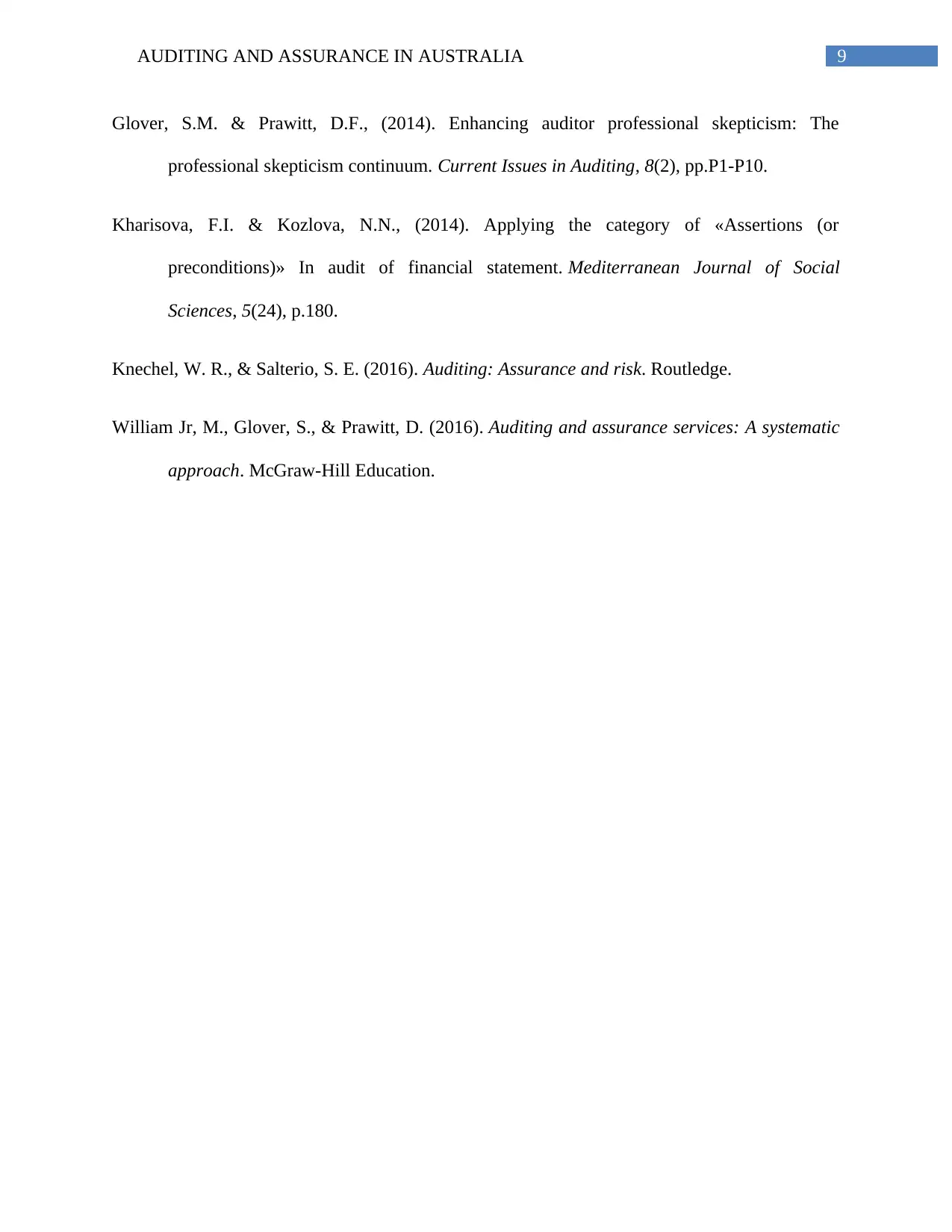
9AUDITING AND ASSURANCE IN AUSTRALIA
Glover, S.M. & Prawitt, D.F., (2014). Enhancing auditor professional skepticism: The
professional skepticism continuum. Current Issues in Auditing, 8(2), pp.P1-P10.
Kharisova, F.I. & Kozlova, N.N., (2014). Applying the category of «Assertions (or
preconditions)» In audit of financial statement. Mediterranean Journal of Social
Sciences, 5(24), p.180.
Knechel, W. R., & Salterio, S. E. (2016). Auditing: Assurance and risk. Routledge.
William Jr, M., Glover, S., & Prawitt, D. (2016). Auditing and assurance services: A systematic
approach. McGraw-Hill Education.
Glover, S.M. & Prawitt, D.F., (2014). Enhancing auditor professional skepticism: The
professional skepticism continuum. Current Issues in Auditing, 8(2), pp.P1-P10.
Kharisova, F.I. & Kozlova, N.N., (2014). Applying the category of «Assertions (or
preconditions)» In audit of financial statement. Mediterranean Journal of Social
Sciences, 5(24), p.180.
Knechel, W. R., & Salterio, S. E. (2016). Auditing: Assurance and risk. Routledge.
William Jr, M., Glover, S., & Prawitt, D. (2016). Auditing and assurance services: A systematic
approach. McGraw-Hill Education.
1 out of 10
Related Documents
Your All-in-One AI-Powered Toolkit for Academic Success.
+13062052269
info@desklib.com
Available 24*7 on WhatsApp / Email
![[object Object]](/_next/static/media/star-bottom.7253800d.svg)
Unlock your academic potential
Copyright © 2020–2025 A2Z Services. All Rights Reserved. Developed and managed by ZUCOL.




